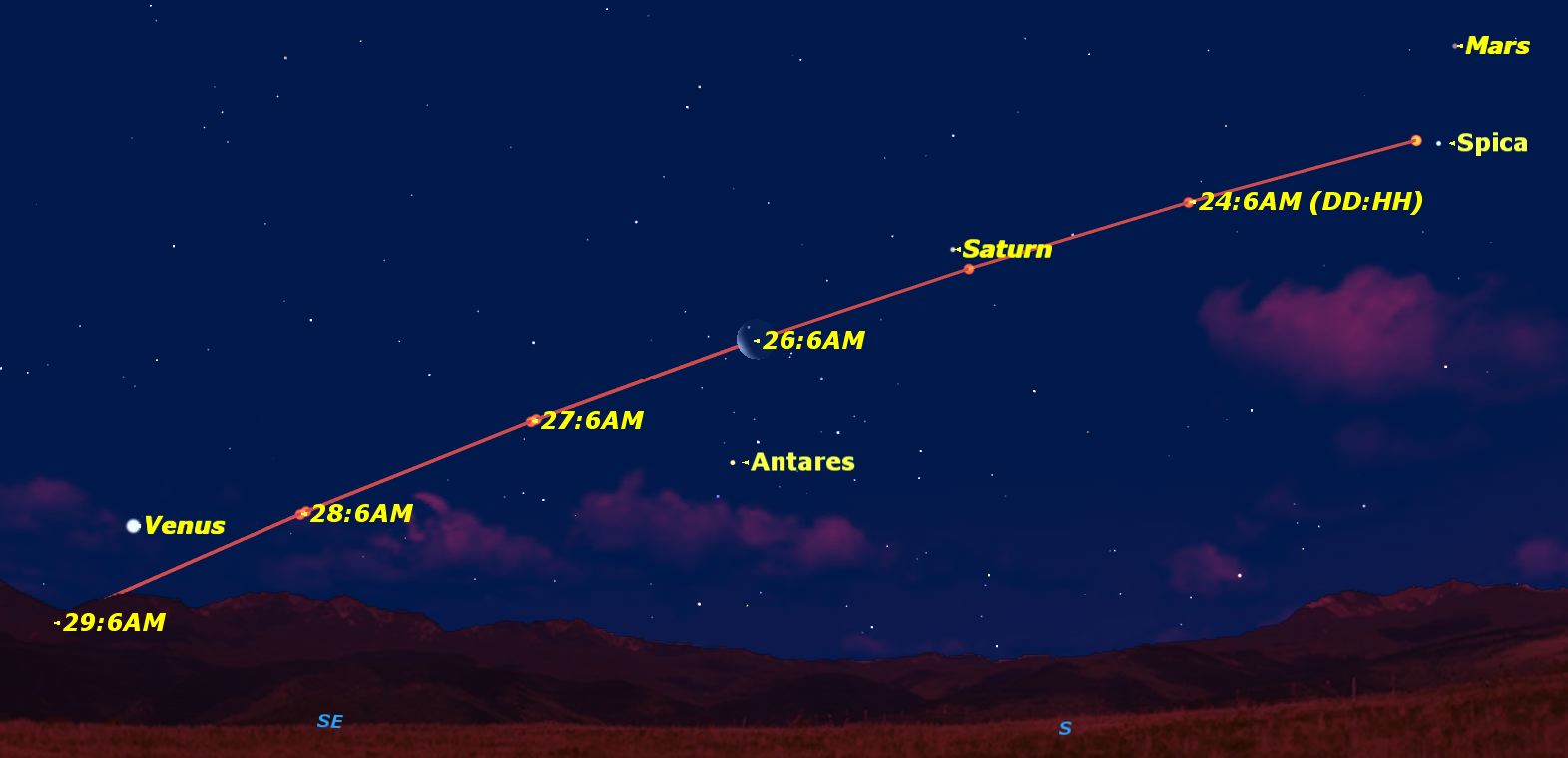See the Moon Dance with Planets, Stars This Week

Early risers will have a great opportunity to watch how the moon moves rapidly across the sky this week.
To see the quick movement of the moon, observers need a set of bright markers across the sky, exactly the kind of signposts in the night sky this week. Two bright stars and three bright planets mark the moon’s path across the sky.
Let’s start by looking for the moon tonight (Jan. 22). Many people are surprised that the moon cannot always be seen in the sky, and this evening is an example of that. In most places tonight the moon will not rise until after midnight. Watch for it rising slowly above the eastern horizon. [See amazing photos taken by skywatchers in January 2014]
Most of the motion you see the moon make in a single night is due to Earth's rotation. The moon is also moving across the background of the stars, but too slowly to be seen with the naked eye.
Once the moon clears the horizon, look carefully around it. You should see a bright star, Spica, just below it, and a reddish object above and to its left. That is the planet Mars, now gradually brightening as it begins its close approach to Earth in April.
Currently Mars is just slightly brighter than Spica, half a magnitude brighter on the astronomer’s brightness scale. By April it will be nearly 2.5 magnitudes brighter than Spica. Mars will move from its present distance of 106 million miles (171 million kilometers) to its closest distance of 57 million miles (92 million km) on April 14.
Spica is far beyond Mars, and far beyond the entire solar system, at 263 light-years distance. For reference, the moon is 1.3 light-seconds away and Mars is at 9.5 light-minutes from Earth.
Breaking space news, the latest updates on rocket launches, skywatching events and more!
Tomorrow night, the moon will have moved so that it’s half way between Spica and Saturn. The night after that (actually Saturday morning) the moon will lie directly below Saturn. Saturn is almost 10 times farther away than Mars, at a distance of 941 million miles (1.5 billion km) Despite its much greater distance, Saturn looks twice as big as Mars in a telescope because it is a far larger body than Mars.
By Sunday morning, the moon will have moved to a spot just above the red giant star Antares. At 604 light-years distance, Antares is more than twice as far away as Spica, yet it is almost identical to Spica in brightness. That’s because Antares is a huge cool star while Spica is smaller and hotter blue star.
By Tuesday morning, the moon will begin to close in on the planet Venus. Venus has just passed between the Earth and the sun, so the planet is quite close to us astronomically speaking, only 29 million miles away (46 million km).
If you’ve been paying attention to the moon itself in its travels, you will have noticed that it has shrunk from a fat gibbous shape on Thursday morning to a half-lit last quarter moon on Friday morning to a slender crescent moon by the end of the week. Our last glimpse of the moon on January 29 is a thin sliver just before it reaches new moon the following day.
Editor's Note: If you have an amazing skywatching photo you'd like to share for a possible story or image gallery, please contact managing editor Tariq Malik at spacephotos@space.com.
This article was provided to SPACE.com bySimulation Curriculum, the leader in space science curriculum solutions and the makers of Starry Night and SkySafari. Follow Starry Night on Twitter @StarryNightEdu. Follow us @Spacedotcom, Facebook and Google+. Original article on SPACE.com.

Geoff Gaherty was Space.com's Night Sky columnist and in partnership with Starry Night software and a dedicated amateur astronomer who sought to share the wonders of the night sky with the world. Based in Canada, Geoff studied mathematics and physics at McGill University and earned a Ph.D. in anthropology from the University of Toronto, all while pursuing a passion for the night sky and serving as an astronomy communicator. He credited a partial solar eclipse observed in 1946 (at age 5) and his 1957 sighting of the Comet Arend-Roland as a teenager for sparking his interest in amateur astronomy. In 2008, Geoff won the Chant Medal from the Royal Astronomical Society of Canada, an award given to a Canadian amateur astronomer in recognition of their lifetime achievements. Sadly, Geoff passed away July 7, 2016 due to complications from a kidney transplant, but his legacy continues at Starry Night.

